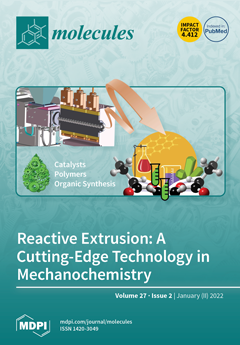The article presents data on the solvent extraction separation of rare-earth elements (REEs), such as La(III), Ce(III), Pr(III), and Nd(III), using synergic mixtures of methyltrioctylammonium nitrate (TOMANO
3) with tri-n-butyl phosphate (TBP) from weakly acidic nitrate solutions. Specifically, experimental results on separation
[...] Read more.
The article presents data on the solvent extraction separation of rare-earth elements (REEs), such as La(III), Ce(III), Pr(III), and Nd(III), using synergic mixtures of methyltrioctylammonium nitrate (TOMANO
3) with tri-n-butyl phosphate (TBP) from weakly acidic nitrate solutions. Specifically, experimental results on separation of REEs, for the pair Ce(III)/Pr(III) for quaternary mixtures of REEs (La(III), Ce(III), Pr(III), Nd(III)) and for the pair La(III)/Pr(III) for solutions containing La(III), Pr(III), and Nd(III), are presented. It was shown that effective separation for the pair Ce(III)/Pr(III) from a solution containing 219 g Ce(III)/L, 106 g La(III)/L, 20 g Pr(III)/L, 55 g Nd(III)/L, and 0.1 mol/L HNO
3, was achieved using 56 steps of a multistage, counter-current solvent extraction cascade with scrubbing, at an organic-to-aqueous phase volume ratio (O/A) equal to 2/1 on the extraction section and O/A equal to 4/1 on the scrubbing section, using 3.3 mol/L solutions of the mixture TOMANO
3-TBP with molar ratio 0.15:0.85 in dodecane. Separation for the pair La(III)/Pr(III) could be achieved using a solvent extraction cascade with scrubbing in 32 steps at O/A equal to 2/1 on the extraction section and O/A equal to 2.8/1 on the scrubbing section of the solvent extraction cascade from a solution containing 258 g La(III)/L, 58 g Pr(III)/L, 141 g Nd(III)/L, and 0.1 mol/L HNO
3 with 3.0 mol/L solution of the mixture TOMANO
3-TBP with molar ratio 0.2:0.8 in dodecane.
Full article






